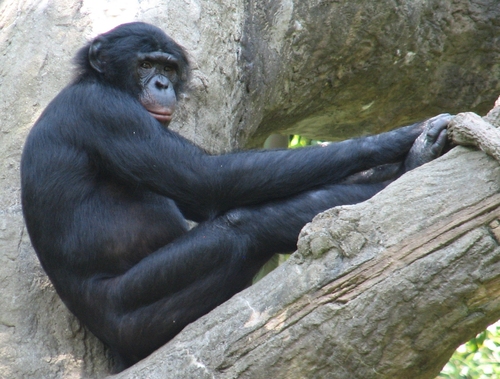
Bonobo
The bonobo (Pan paniscus) thrives in the lush Congolese forests, noted for its matriarchal society and gentle demeanor. With graceful limbs and expressive faces, bonobos engage in complex social bonds and play crucial roles in their ecosystem by dispersing seeds, ensuring vibrant forest diversity.
25.0 - 50.0 kg
Weight
Height: 73 - 90 cm
Size
Brown, Grey, Black
Color
12 years
Age of Sexual Maturity
5-6 years
Age of Weaning
25 mph
Top Speed
Endangered
Conservation Status
Decreasing
Population Trend
Characteristics
Pan paniscus, commonly known as the bonobo, is a great ape found in the forests of the Democratic Republic of the Congo. It is known for its peaceful and matriarchal social structure, high level of social interaction, and intelligence. Bonobos have a slender physique, long limbs, and dark faces. They are predominantly frugivorous, with a diet that also includes leaves, flowers, and small animals. Bonobos play a vital role in seed dispersal, contributing significantly to the health of their forest habitat.
Distribution Range of the Bonobo
Pan paniscus, commonly known as the bonobo, is native to the Democratic Republic of the Congo (DRC) in Central Africa. The species is found south of the Congo River, in a region bounded by the Kasai River to the south and the Lualaba River to the east. This area is often referred to as the Congo Basin, which is one of the most biodiverse regions in the world.
Bonobo's Habitat
Environmental Conditions
Bonobos inhabit tropical rainforests, which are characterized by high temperatures and significant rainfall throughout the year. The climate is typically humid and supports dense forest vegetation. These rainforests provide a complex canopy structure that is crucial for the arboreal lifestyle of bonobos.
Ecological Niche
Bonobos occupy a niche as frugivorous primates, primarily feeding on fruits, but they also consume leaves, flowers, seeds, and occasionally small animals or invertebrates. They play an important ecological role in seed dispersal, which is vital for forest regeneration. Bonobos are known for their social structure and behaviors, which are distinct from their closest relatives, the chimpanzees (Pan troglodytes). Their social systems are matriarchal, and they exhibit a high degree of social bonding and cooperation.
Copyright @ Nature Style Limited. All Rights Reserved.
 English
English